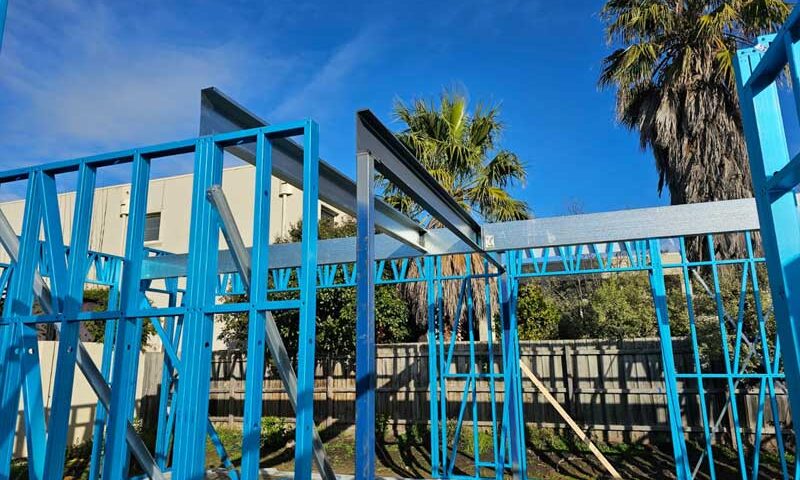The effectiveness of steel frames in architecture is a topic of significant interest and importance in the fields of architectural steel fabrication and structural steel fabrication. We will explain the various aspects that underscore the efficiency of using steel frames in building construction.
Strength and Durability of Architectural Steel Fabrication
One of the primary reasons for the effectiveness of steel frames in architecture is their exceptional strength and durability. Steel, being a robust material, can withstand severe weather conditions, heavy loads, and high pressures, making it an ideal choice for architectural steel fabrication. This durability ensures that structures are not only safe but also have a longer lifespan, reducing the need for frequent repairs and maintenance.
Flexibility and Adaptability
Steel frames offer remarkable flexibility and adaptability in design. Their ability to be molded into various shapes and sizes allows architects and builder renovators to explore creative and innovative design options. This flexibility is particularly advantageous in modern architectural steel fabrication, where bespoke and unique designs are increasingly sought after.
Speed of Construction
Another key aspect of steel frames is the speed at which they can be constructed. In comparison to traditional construction materials like concrete or wood, steel frames can be prefabricated off-site and then quickly assembled on-site. This fast-paced construction is beneficial for builder renovators as it reduces overall project timelines and allows for quicker occupancy, which is particularly valuable in commercial and industrial construction.
Sustainability and Environmental Impact
Steel frames are also notable for their sustainability. Steel is one of the most recycled materials in the world, and its ability to be reused or recycled without losing quality is a significant advantage in terms of environmental impact. Furthermore, the efficiency of structural steel fabrication leads to less waste during construction. For builder renovators, using steel frames aligns with the growing demand for environmentally responsible construction practices.
Cost-Effectiveness
In terms of cost-effectiveness, steel frames are an excellent option. While the initial costs might be higher than other materials, the longevity, low maintenance requirements, and energy efficiency of steel frames make them a more economical choice in the long run. Builders find that the reduced need for replacements and repairs compensates for the initial investment over time.
Resistance to Pests and Decay
Unlike traditional building materials like wood, steel frames are resistant to pests, mold, and decay. This resistance contributes significantly to the longevity and durability of structures, making steel an ideal choice for architectural steel fabrication, particularly in areas prone to termites or moisture.
Fire Resistance
Steel frames offer superior fire resistance compared to other construction materials. This fire resistance enhances the safety of buildings and is a critical factor considered by builder renovator when choosing materials for structural steel fabrication. The fire-resistant properties of steel also potentially lower insurance costs, adding to its cost-effectiveness.
Challenges in Using Steel Frames
Despite their numerous advantages, there are challenges associated with using steel frames in construction. These include susceptibility to corrosion in certain environments and the need for specialized labor for installation. However, advancements in protective coatings and the increasing skill level of workers in the field of structural steel fabrication are effectively addressing these challenges.
Impact on Architectural Trends
Steel frames have significantly impacted architectural trends, enabling the construction of high-rise buildings, long-span bridges, and large industrial facilities. Their strength and versatility have opened up new possibilities in architectural design, allowing for more daring and expansive structures.
Integration with Other Materials
Steel frames can be effectively integrated with other materials such as glass, wood, or concrete, offering a blend of aesthetics and functionality. This integration is a key consideration in architectural steel fabrication, as it allows for diverse design possibilities and enhances the overall appeal of the structure.
Technological Advancements in Steel Fabrication
Technological advancements in steel fabrication, such as 3D modeling and automated cutting tools, have further enhanced the effectiveness of steel frames in construction. These advancements allow for more precise and efficient fabrication, reducing errors and waste in the process.
Steel frames are highly effective in architectural and structural steel fabrication due to their strength, durability, flexibility, and sustainability. Their advantages in terms of speed of construction, cost-effectiveness, and environmental impact make them a preferred choice for builder renovators and architects alike. As the industry continues to evolve, the role of steel frames in shaping modern architecture and construction is expected to grow, underlining their significance in the future of building and design.

